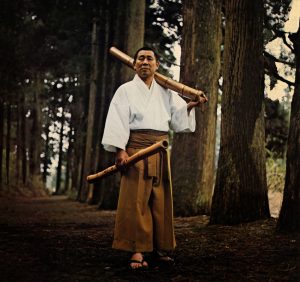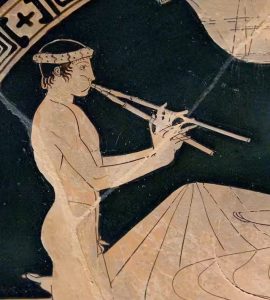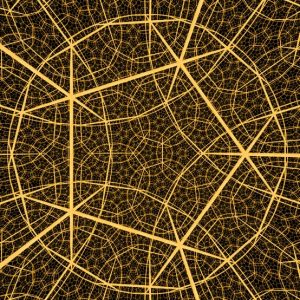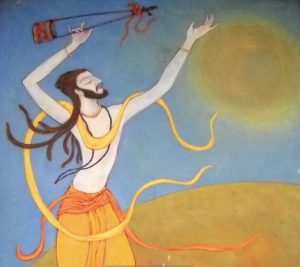The Way of Watazumi
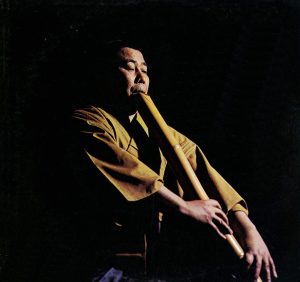
The Way of Watazumi
“(Watazumi Doso) is perhaps the greatest improviser I ever heard in my life. The is sound is more modern than anybody in jazz, the concept (he has) of sound as material is timeless, ancient and super-modern. He’s playing with the components of sound, the vibrations. This man rises every morning and goes into the forest near his house and practices until dawn with the birds and the wind. And he is a master of wind himself, he has a complete mastery of sound. His diaphragm is astonishing, uncanny. He is playing extremely dramatic, daring, full of invention.”
Steve Lacy on Watazumi (The Wire, June 1992)
INTERVIEW
“The Way of Watazumi then, is to express in sound your own life force.”
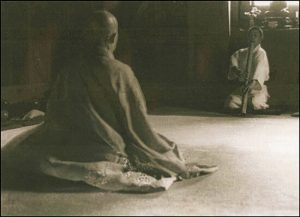
This is an edited transcript of a lecture/demonstration which was given by Watazumido Doso Roshi at the Creative Music Studio, Woodstock, N.Y., in the fall of 1981. In this conversation with approximately 25 music Students, Doso Roshi describes certain central elements in his philosophy and practice.
Regarding himself as something other than a “musician,” he bases his music in an uncompromising vigorous physical discipline. He is a practitioner of the Jo stick, a long hardwood pole with which he stretches, exercises, massages, pounds, and invigorates his body. His Jo Stick practice is part of a daily exercise regimen which begins at 3:30 AM. For over 3,000 consecutive days he has maintained this practice, often accompanied by his wife, who was with him on this American visit.
Doso Roshi was 71 years old at the time that this talk was given. Years ago he studied Rinzai Zen, attaining the title of Roshi, or Master. He later became the Kanjo, the unifying head of the Fuke sect of Zen Buddhism. He shunned traditional organized Zen practice 32 years ago in favor of a practice of his own devising with breath training and vigorous exercise at its core. The lengthening of the Out Breath to which he refers is directly descended from the wisdom of the breath as practiced in Zen. (The Soto-Zen teachings of Shunryu Suzuki Roshi emphasize precisely that lengthening of the Out Breath. See Zen Mind, Beginners Mind, Weatherhill, New York, 1970) So Doso Roshi’s music is based in a psychophysical discipline related to Zen breath awareness and to the martial arts.
It is said that the bamboo flute, the most standard variety of which in Japan is called the Shakuhachi, was used by a particular sect of Zen priests as a weapon-in-disguise after the carrying of samurai swords was outlawed in the Meiji period. The priests of the Fuke sect would wander about playing the bamboo flute-a meditative pursuit-but perhaps also a spy’s cover, his eyes and face concealed beneath a woven basket, his flute a handy club.
Doso Roshi’s comments are translated by Chris Jay with admirable spontaneity. The transcription from tape is by Lucian Burg. Editing of the transcript and these notes are by Stuart Leigh.
(taken from The International Shakuhachi Society website)
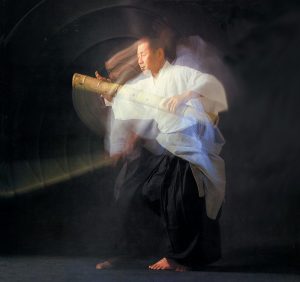
Everybody please sit comfortably. And now I will tell a little about the Way of Watazumi.
The Way of Watazumi has come from an old Japanese word. I was born in Japan and the way I live is through Japanese customs, but just because my way was born with me in Japan does not mean that it can only be transmitted or learned in Japan. If I had been born in this county, or any other country, I would still be teaching you the Way of Watazumi, but maybe in a different form.
It’s fine that you are all deep into music. But there’s something deeper and if you would go deeper, if you go to the source of where the music is being made, you’ll find something even more interesting. At the source, everyone’s individual music is made. If you ask what the deep place is, it’s your own life and it’s knowing your own life, that own way that you live.
The Way of Watazumi then is to take your life force, your life strength, and to train it into being stronger and healthier. If you ask what life force is, it’s a difficult thing to understand in its essence. The deeper you go, the less you can see what it is. But whether you understand it or not, you still have to get through life; you still have to do your daily things. And so using your daily life, using the things you do all day, we train and strengthen the life force. There are various different ways to train the life force and the life strength. From those various ways, the Way of Watazumi has chosen five ways.
The first basis is breathing out. And that breathing out has to do with the entire system of breathing. So what is most useful to the strength of your life force is lengthening the Out Breath instead of worrying about the In Breath. The lengthening of the out breath is the most important and we call that Haku.
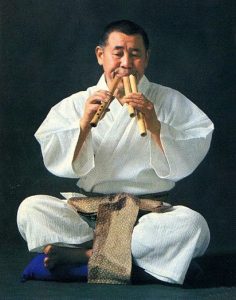
Next we have Tsukami, which means, “to grasp”. And that refers to the movement of the fingers and the feet. The ability of your fingers to move freely in any direction. A person who cannot move their fingers freely is indicating already that his blood vessels are stopped up and undeveloped. And so I meet a musician and look at the movement of his fingers I don’t even need to hear his playing or his instrument to know what kind of musician he is. So everybody, the movement of the fingers is extremely important. However, just the simple movement of the fingers is not the only thing. You also have to look at the movement of the legs and toes. You all wear around shoes and heavy boots that cramp your feet and cramp the movement of the toes. So, at least, when you have your shoes off and you are taking a bath, you should make extra effort to move your toes around so that they can move in any direction freely. And so to repeat again, if your fingers cannot move freely in any direction with complete alacrity, then there is no way your playing of the instrument can be any good.
The next is called Nobasu, which means “to lengthen.” If you ask what to lengthen, it is your entire body. To move the thick muscles of the body, is extremely important. And moving the largest muscle sections in your body will also bring into play all of the smaller muscles. And so, when you are playing an instrument, it’s not simply the movement of your fingers or this or that, it’s the movement and the action of the entire body.
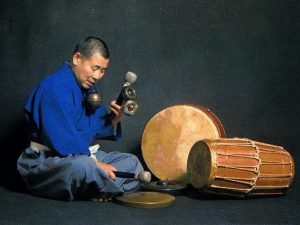
And when you consider rhythm, rhythm is not just simply rhythm; rhythm is the movement of the entire body from its last cell. And that movement differs from person to person because everybody’s flow of blood is different. If you look at a person’s pulse, the pulse for a normal person is somewhere around 70. The more you move the faster the pulse becomes. A famous doctor from Germany named Aiken has indicated that a pulse of over 120 per minute is dangerous for the body. And he has said that a pulse of up to 120 through vigorous exercise is extremely beneficial for the body. At one moment in the body there has to be five liters of blood being pumped through. If there is not that much, then we cannot have any action at all. Everybody has that movement within their bodies. You have to balance, then, the movement of your pulse with the movement of your body.
The center of music is the pulse, And so the reason that you stretch and exercise the large muscle sections of your body is to improve and strengthen your pulse; to train your pulse.
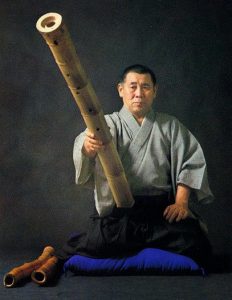
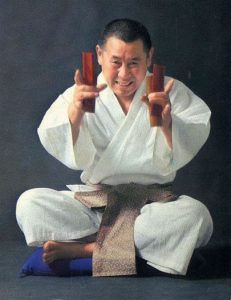
When you play music, you might be reading the written music on the page while you are playing, but that’s no good. You should not feel that you are depending on the written music in order to play. You are not depending on the music, you are moving that written music yourself and there is no difference, then, between that written music and you. And so you have to train yourself in all aspects in order to be able to do anything good at all with the music. Just doing music is simply reproducing what is written on a score. If you look at it deeper, it is taking your own health, your own power, your own strength, and training it and moving it, which is the deeper aspect of music. In the Way of Watazumi we use sounds, but the reason that we use sounds is to get to the basics of the human life, of the human health and the strength..
Now looking at breathing, I see four different kinds of breathing. Number one is Rough Breathing, and then Strong Breathing, Soft Breathing and Weak Breathing. The kinds of breathing that we use in playing these Jogu flutes are these four. These four kinds of breathing are not the breathing used in normal daily life. What is used in normal daily life is the Unconscious Breathing. Unconscious Breathing is simply the movement of the lungs. But just using the Unconscious Breathing, the simple movement of the lungs, does not bring a person into strength or health. You are sure to become sick or even die. And so you have to move away from Unconscious Breathing and come into Conscious or Mindful Breathing.
I suspect probably that the breathing most of you wind musicians do into your instruments is a certain kind of Unconscious Breathing. Unconscious Breathing is similar to a pool of water that has been stopped up and is sitting there and stagnating. Just like a river that has not been stopped up, the river that flows cleanly and purely, that is how the conscious breathing affects the inside of the body.
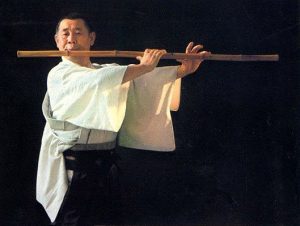
How can you tell if a person is breathing unconsciously or mindfully? Now, you can generally tell by the amount of oxygen a person takes in. Human beings have to take in as much oxygen as they possibly can. There are three main sicknesses that seem to affect the older people these days. Number one is cancer. Then there is brain disease. And the reason for these diseases is a lack of oxygen. You have to take in as much oxygen as possible. And taking in as much oxygen as possible, you breathe mindfully. If you begin breathing mindfully and training your breath for the different kinds of strength, then you will develop your own individual music.
You all have to give up the idea of wanting to become good or great at music. I’m 71, but it has taken me 50 years to develop my own kind of breathing. And so instead of wanting to get great really quickly, you have to be willing to work at music for many, many years.
When I train students in the Way of Watazumi, the first thing I train them in is the Rough Breathing. What I’m going to do now I don’t call performing or playing for people. Instead I call it the Concentrated Breathing. To blow is just simply a technique. My kind of blowing is not just simply blowing, it’s the movement of the entire personality. Just to repeat again what I was saying, the movement of the life force, the movement that comes out of the instrument, is just simply your own pulse. The Way of Watazumi then, is to express in sound your own life force.
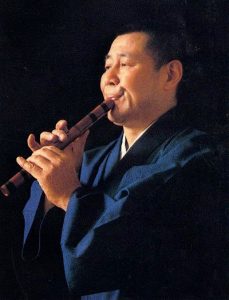
What I call these flutes is the Sui Jo Do Gu. Sui Jo means concentrated breathing and Do-Gu means tool. I abbreviate the whole term to Jogu. Before I start with the concentrated blowing, I move my body as vigorously as possible. There are different ways to move your body vigorously. No matter how you do it is O.K. (claps once loudly) You can do something like that. And then you bow. This is not simply praying and some sort of religion. What you do with your hands together is to unify your breath.
In order to understand the breath and to get into the deeper uses of the breath for your own person you have to use a natural piece of bamboo. When you use a piece of bamboo that is as natural as this, then you understand the entire natural world. And if you ask what I mean by understanding the entire natural world, when I play a natural simple piece of bamboo out in the forest, different animals then come around. Generally what I play when I play these flutes are not the tiny ones but the very long flutes. You put in a lot of breath but you get out hardly any sound at all. Modern instruments are designed so that you put in the least breath possible and get out the most sound. But playing this kind of bamboo flute, you don’t have to worry about what kind of sound or its quality, whether it sounds good or it sounds bad. So if you have your own freedom on the inside, then you can change the sound freely to make it stronger or softer.
So in that sound you have to put in your balls, your strength and your own specialness. And what you are putting in their, is your own life and your own life force.
When you hear some music or hear some sound, if for some reason you like it very well; the reason is that sound is in balance or in harmony with your pulse. And so making a sound, you try to make various different sounds that imitate various different sounds of the universe, but what you are finally making is your own sound, the sound of yourself.
